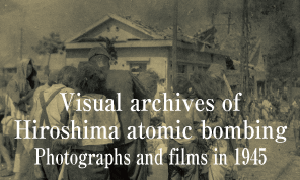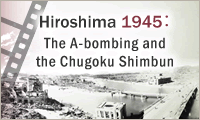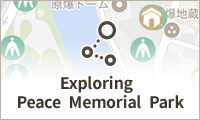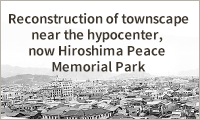Documenting Hiroshima of 1945: August 10, with “inarticulate groans,” the wounded flooded into Red Cross Hospital
Aug. 10, 2024
by Maho Yamamoto, Staff Writer
On August 10, 1945, Hajime Miyatake, 31 at the time, who died in 1985 at the age of 71, headed to the Hiroshima Red Cross Hospital (present-day Hiroshima Red Cross Hospital & Atomic-bomb Survivors Hospital, in Hiroshima’s Naka Ward) with his camera in hand. Mr. Miyatake was a staff photographer for the Asahi Shimbun’s Osaka head office and had entered Hiroshima the previous day, accompanying a military information-gathering team. He was shocked by the scenes he witnessed at the hospital.
“Seeing the many critically injured people laid out on the concrete floor and hearing their inarticulate groans, I stood paralyzed with the camera in my hand,” wrote Mr. Miyatake in an excerpt from his personal notes collected in the collection Genshi-gumo (in English, ‘Atomic cloud’),” published in 1982.
The hospital was located around 1.5 kilometers from the hypocenter. While many other hospitals in the city had burned to the ground, the ferroconcrete building of the Hiroshima Red Cross hospital, which had avoided collapse and incineration by the fires, was overflowed with the wounded, including a woman whose face had been seared by the A-bombing’s thermal rays, an infant with severe head injuries, and others lying outside the hospital entrance due to the lack of space inside. It was those scenes that Mr. Miyatake snapped with his camera.
51 hospital employees killed in bombing
There, in that place of extreme tragedy, Katsuko Ikuta, 95, a resident of the town of Tsuwano in Shimane Prefecture, helped with relief efforts immediately after the atomic bombing. Ms. Ikuta was 16 at the time and a first-year student in the nurse training school attached to the hospital. She said, “The only care I could provide at the time was to apply zinc oil to the wounds and remove maggots with tweezers.”
On August 6, Ms. Ikuta herself had been trapped under the pillar of a wooden dormitory after its collapse from the A-bomb’s blast. Before the fires reached her, she was able to survive by crawling out from underneath the pillar, but she had suffered wounds to her back. Fifty one of the hospital employees had been killed in the bombing. With its facilities severely damaged, the hospital very quickly ran short of medical supplies and materials.
Bandages and other materials reused
“Many people wore mostly burned clothes with skin hanging from their burned arms,” described Ms. Ikuta. Based on orders from upper classmates, she continued washing used bandages and gauze with tap water so they could be reused. One night, she heard the cries of an infant in one of the hospital rooms, approached, and found that the mother lying beside the baby had died. She said, “At the time, I had no capacity to feel sad. But I still can’t forget that baby.”
Mr. Miyatake also took photographs of the wounded receiving treatment from a physician at the Hiroshima Red Cross Hospital. One of the photos, with the caption “Young boy receiving treatment for his burns at Hiroshima Red Cross Hospital,” is on display at the Hiroshima Peace Memorial Museum. Two years ago, Shogo Harada, 51, a resident of Settsu City in Osaka Prefecture, came forward to report that the boy in the photo was his father, Nario Harada, who was 16 at the time of the bombing and died in 1999 at the age of 70. When Shogo visited the museum with his father when he was still alive, he heard his father say, “That is me.”
Shogo has continued to hold onto his father’s “certificate of authenticity,” written in 1978 by a nurse involved in the youth’s treatment which described the situation at the time and something he inherited from his father. His father was originally from Kagoshima City in Kagoshima Prefecture, and at the time of the bombing served as a member of the former Army Ship Communications Reserve. He experienced the atomic bombing at his camp site, the school yard of Senda National School (present-day Senda Elementary School, in Hiroshima’s Naka Ward), around 1.7 kilometers from the hypocenter. The certificate indicates, “Severe burns made opening his mouth difficult and eating and drinking persistently impossible, with the patient sometimes slipping into unconsciousness.”
Shogo said, “I hardly had the chance to listen to my father’s experience in the atomic bombing directly from him.” But the photo vividly communicates his father’s pain.
(Originally published on August 10, 2024)
On August 10, 1945, Hajime Miyatake, 31 at the time, who died in 1985 at the age of 71, headed to the Hiroshima Red Cross Hospital (present-day Hiroshima Red Cross Hospital & Atomic-bomb Survivors Hospital, in Hiroshima’s Naka Ward) with his camera in hand. Mr. Miyatake was a staff photographer for the Asahi Shimbun’s Osaka head office and had entered Hiroshima the previous day, accompanying a military information-gathering team. He was shocked by the scenes he witnessed at the hospital.
“Seeing the many critically injured people laid out on the concrete floor and hearing their inarticulate groans, I stood paralyzed with the camera in my hand,” wrote Mr. Miyatake in an excerpt from his personal notes collected in the collection Genshi-gumo (in English, ‘Atomic cloud’),” published in 1982.
The hospital was located around 1.5 kilometers from the hypocenter. While many other hospitals in the city had burned to the ground, the ferroconcrete building of the Hiroshima Red Cross hospital, which had avoided collapse and incineration by the fires, was overflowed with the wounded, including a woman whose face had been seared by the A-bombing’s thermal rays, an infant with severe head injuries, and others lying outside the hospital entrance due to the lack of space inside. It was those scenes that Mr. Miyatake snapped with his camera.
51 hospital employees killed in bombing
There, in that place of extreme tragedy, Katsuko Ikuta, 95, a resident of the town of Tsuwano in Shimane Prefecture, helped with relief efforts immediately after the atomic bombing. Ms. Ikuta was 16 at the time and a first-year student in the nurse training school attached to the hospital. She said, “The only care I could provide at the time was to apply zinc oil to the wounds and remove maggots with tweezers.”
On August 6, Ms. Ikuta herself had been trapped under the pillar of a wooden dormitory after its collapse from the A-bomb’s blast. Before the fires reached her, she was able to survive by crawling out from underneath the pillar, but she had suffered wounds to her back. Fifty one of the hospital employees had been killed in the bombing. With its facilities severely damaged, the hospital very quickly ran short of medical supplies and materials.
Bandages and other materials reused
“Many people wore mostly burned clothes with skin hanging from their burned arms,” described Ms. Ikuta. Based on orders from upper classmates, she continued washing used bandages and gauze with tap water so they could be reused. One night, she heard the cries of an infant in one of the hospital rooms, approached, and found that the mother lying beside the baby had died. She said, “At the time, I had no capacity to feel sad. But I still can’t forget that baby.”
Mr. Miyatake also took photographs of the wounded receiving treatment from a physician at the Hiroshima Red Cross Hospital. One of the photos, with the caption “Young boy receiving treatment for his burns at Hiroshima Red Cross Hospital,” is on display at the Hiroshima Peace Memorial Museum. Two years ago, Shogo Harada, 51, a resident of Settsu City in Osaka Prefecture, came forward to report that the boy in the photo was his father, Nario Harada, who was 16 at the time of the bombing and died in 1999 at the age of 70. When Shogo visited the museum with his father when he was still alive, he heard his father say, “That is me.”
Shogo has continued to hold onto his father’s “certificate of authenticity,” written in 1978 by a nurse involved in the youth’s treatment which described the situation at the time and something he inherited from his father. His father was originally from Kagoshima City in Kagoshima Prefecture, and at the time of the bombing served as a member of the former Army Ship Communications Reserve. He experienced the atomic bombing at his camp site, the school yard of Senda National School (present-day Senda Elementary School, in Hiroshima’s Naka Ward), around 1.7 kilometers from the hypocenter. The certificate indicates, “Severe burns made opening his mouth difficult and eating and drinking persistently impossible, with the patient sometimes slipping into unconsciousness.”
Shogo said, “I hardly had the chance to listen to my father’s experience in the atomic bombing directly from him.” But the photo vividly communicates his father’s pain.
(Originally published on August 10, 2024)






